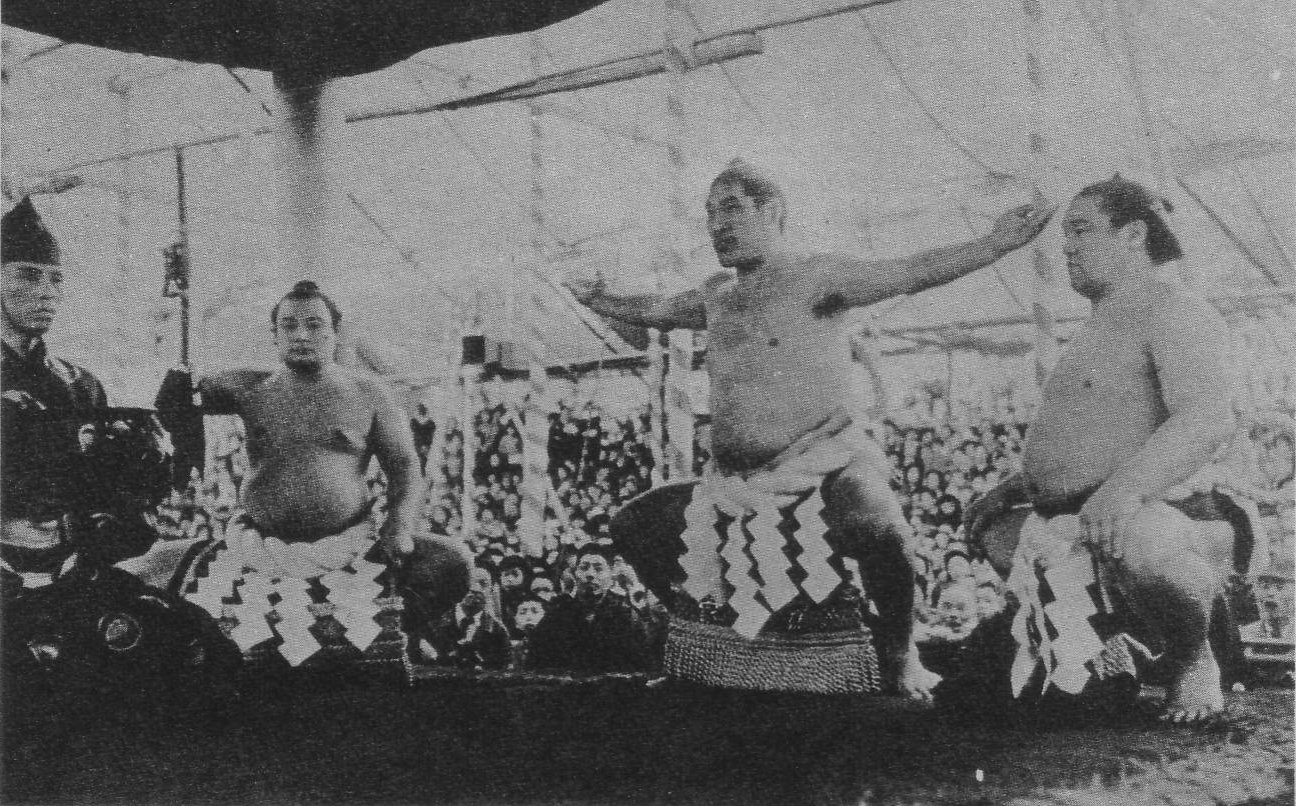Tachimochi on:
[Wikipedia]
[Google]
[Amazon]
 In professional
In professional
sumo
is a form of competitive full-contact wrestling where a ''rikishi'' (wrestler) attempts to force his opponent out of a circular ring (''dohyō'') or into touching the ground with any body part other than the soles of his feet (usually by th ...
, the ''tachimochi'' (太刀持ち; lit.: sword carrier) is one of the two attendants that accompany a ''yokozuna
, or , is the top division of the six divisions of professional sumo. Its size is fixed at 42 wrestlers ('' rikishi''), ordered into five ranks according to their ability as defined by their performance in previous tournaments.
This is the o ...
'' when he performs his ''dohyō-iri
The following words are terms used in sumo wrestling in Japan.
A
B
C
D
E
F
G
H
...
'', or ring entrance ceremony. The other attendant is called the ''tsuyuharai
In professional sumo, the ''tsuyuharai'' (Japanese: 露払い, literally "dew sweeper") is one of the two attendants that accompany a ''yokozuna'' when he performs his '' dohyō-iri'' or ring entrance ceremony. The other attendant is called the ...
''.
During the ceremony, the ''tachimochi'' will follow the ''yokozuna'', carrying his sword
A sword is an edged and bladed weapons, edged, bladed weapon intended for manual cutting or thrusting. Its blade, longer than a knife or dagger, is attached to a hilt and can be straight or curved. A thrusting sword tends to have a straighter ...
in his right hand, to the ring and squat on his right hand side. The ''yokozunas sword is a traditional indication of his samurai
The samurai () were members of the warrior class in Japan. They were originally provincial warriors who came from wealthy landowning families who could afford to train their men to be mounted archers. In the 8th century AD, the imperial court d ...
status. After the ''yokozuna'' has completed his ceremonial dance, the ''tachimochi'' will once again follow him off the ''dohyō''.
The ''tachimochi'' must be a ''makuuchi
, or , is the top division of Professional sumo divisions, the six divisions of professional sumo. Its size is fixed at 42 wrestlers (''rikishi''), ordered into five ranks according to their ability as defined by their performance in previous ...
'' ranked sumo wrestler (or ''rikishi
A , or, more colloquially, , is a sumo wrestler. Although used to define all wrestlers participating in sumo wrestling matches, the term is more commonly used to refer to professional wrestlers, employed by the Japan Sumo Association, who par ...
'') and is, if possible, from the same training stable (or ''heya'') as the ''yokozuna''. If there are no appropriate choices from within the stable then the ''tachimochi'' will normally be from another related stable (from the same stable grouping called an ''ichimon
The following words are terms used in sumo wrestling in Japan.
A
B
C
D
E
F
G
H
...
''). The ''tachimochi'' is always the higher ranked wrestler of the two attendants.
All three wrestlers will wear a matching set of ''keshō-mawashi
In sumo, a is the loincloth that (sumo wrestlers) wear during training or in competition. Upper ranked professional wrestlers wear a as part of the ring entry ceremony or .
''Mawashi''
''Sekitori'' During competition
For top ranked professi ...
'' belonging to the ''yokozuna'' during the ceremony, and as the ceremony is directly after the ring entry ceremony for the ''makuuchi'' division wrestlers on a tournament day this means that the ''tachimochi'' will also wear the ''yokozunas ''keshō-mawashi'' for his own entrance.
A wrestler who is scheduled to fight the ''yokozuna'' on a particular day of a ''honbasho
A , or Grand Sumo Tournament in English, is an official professional sumo tournament. Only ''honbasho'' results matter in determining promotion and relegation for '' rikishi'' (sumo wrestlers) on the '' banzuke'' ranking. The number of ''honbash ...
'' (or tournament) will not act as his ''tachimochi''.
In normal circumstances, the ''tachimochi'' will not be another ''yokozuna'' or an '' ōzeki''. An ''ōzeki'' can act as a ''tachimochi'' during a wrestler's very first ''dohyō-iri'', held at Meiji Shrine
is a Shinto shrine in Shibuya, Tokyo, that is dedicated to the deified spirits of Emperor Meiji and his wife, Empress Shōken. The shrine does not contain the emperor's grave, which is located at Fushimi-ku, Kyoto#Sights, Fushimi-momoyama, south ...
in Tokyo
Tokyo, officially the Tokyo Metropolis, is the capital of Japan, capital and List of cities in Japan, most populous city in Japan. With a population of over 14 million in the city proper in 2023, it is List of largest cities, one of the most ...
. A ''yokozuna'' will only usually fulfil this role at another ''yokozunas retirement ceremony, or at a special event after the other ''yokozuna'' has announced his retirement, but before the final ceremony.
References
{{Reflist Sumo terminology